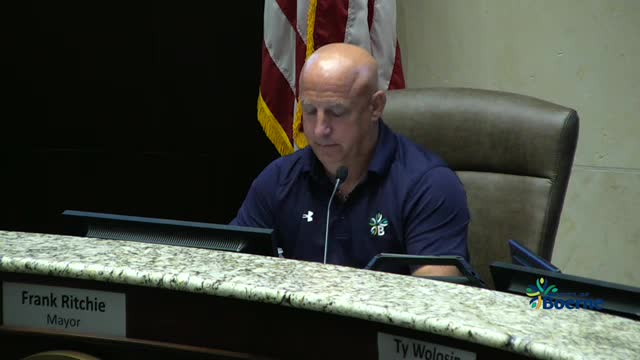Boerne council hears options to raise stormwater fees to fund major drainage projects
October 14, 2025 | Boerne, Kendall County, Texas
This article was created by AI summarizing key points discussed. AI makes mistakes, so for full details and context, please refer to the video of the full meeting. Please report any errors so we can fix them. Report an error »

City staff told the Boerne City Council on Tuesday that the city’s stormwater utility — created by ordinance in 2019 and collecting fees since January 2021 — currently serves roughly 6,774 accounts and generates about $650,000 annually, and that the city’s drainage master plan lists more than $60 million in projects.
Jeff Carroll, the city director who presented the utility update, said the city calculated an equivalent residential unit (ERU) of 4,700 square feet of impervious cover and currently charges $4 per ERU per month. Carroll said that doubling the fee to $8 could allow the city to finance priority projects, like the Manger Creek Bridge, using debt issuance over roughly 20 years.
“The project did grow from the initial schematic concept to actually doing a design,” Carroll said when describing why the Manger Creek Bridge estimate rose to about $11.8 million. He told the council the bridge design now incorporates intersection and mobility improvements identified in the city’s mobility master plan.
Council members pressed staff on priorities, affordability and next steps. Councilman Willison asked what a reasonable 10‑year plan would look like; Councilman Bateman discussed project cost escalation; and Councilman Wilson and others asked staff to model fee structures that would (a) fund high‑priority public‑safety projects and (b) include relief for residents on fixed incomes.
Dr. Maddon, who said he had participated in the stormwater committee that developed the ordinance, warned that even a doubled fee would not cover the full backlog and recommended a combination of fee increases, prioritization and debt issuance. “We’re gonna have to prioritize what are the highest risk areas for public safety,” he said.
Carroll described the city’s method: aerial imagery and parcel‑level impervious coverage were used to set the residential ERU and the four residential tiers in the ordinance. He said staff will return with more detailed scenarios showing what different rate increases could achieve and how they could be structured to protect low‑income or fixed‑income households.
No ordinance or rate change was adopted at the meeting; council asked staff to prepare fee scenarios, debt‑issuance options and an analysis of exemptions or discounts for residents on fixed incomes.
Jeff Carroll, the city director who presented the utility update, said the city calculated an equivalent residential unit (ERU) of 4,700 square feet of impervious cover and currently charges $4 per ERU per month. Carroll said that doubling the fee to $8 could allow the city to finance priority projects, like the Manger Creek Bridge, using debt issuance over roughly 20 years.
“The project did grow from the initial schematic concept to actually doing a design,” Carroll said when describing why the Manger Creek Bridge estimate rose to about $11.8 million. He told the council the bridge design now incorporates intersection and mobility improvements identified in the city’s mobility master plan.
Council members pressed staff on priorities, affordability and next steps. Councilman Willison asked what a reasonable 10‑year plan would look like; Councilman Bateman discussed project cost escalation; and Councilman Wilson and others asked staff to model fee structures that would (a) fund high‑priority public‑safety projects and (b) include relief for residents on fixed incomes.
Dr. Maddon, who said he had participated in the stormwater committee that developed the ordinance, warned that even a doubled fee would not cover the full backlog and recommended a combination of fee increases, prioritization and debt issuance. “We’re gonna have to prioritize what are the highest risk areas for public safety,” he said.
Carroll described the city’s method: aerial imagery and parcel‑level impervious coverage were used to set the residential ERU and the four residential tiers in the ordinance. He said staff will return with more detailed scenarios showing what different rate increases could achieve and how they could be structured to protect low‑income or fixed‑income households.
No ordinance or rate change was adopted at the meeting; council asked staff to prepare fee scenarios, debt‑issuance options and an analysis of exemptions or discounts for residents on fixed incomes.
Don't Miss a Word: See the Full Meeting!
Go beyond summaries. Unlock every video, transcript, and key insight with a Founder Membership.
✓
Get instant access to full meeting videos
✓
Search and clip any phrase from complete transcripts
✓
Receive AI-powered summaries & custom alerts
✓
Enjoy lifetime, unrestricted access to government data
30-day money-back guarantee

